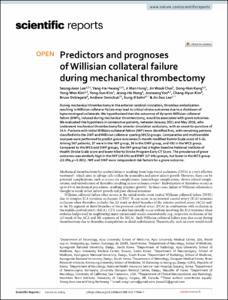Predictors and prognoses of Willisian collateral failure during mechanical thrombectomy
- Keimyung Author(s)
- Hong, Jeong Ho; Yoo, Joon Sang; Kim, Chang Hyun; Sohn, Sung Il
- Journal Title
- Scientific Reports
- Issued Date
- 2020
- Volume
- 10
- Abstract
- During mechanical thrombectomy in the anterior cerebral circulation, thrombus embolization resulting in Willisian collateral failure may lead to critical stroke outcomes due to a shutdown of leptomeningeal collaterals. We hypothesized that the outcomes of dynamic Willisian collateral failure (DWF), induced during mechanical thrombectomy, would be associated with grave outcomes. We evaluated this hypothesis in consecutive patients, between January 2011 and May 2016, who underwent mechanical thrombectomy for anterior circulation occlusions, with an onset-to-puncture of 24 h. Patients with initial Willisian collateral failure (IWF) were identified first, with remaining patients classified into the DWF and Willisian collateral sparing (WCS) groups. Comparative and multivariable analyses were performed to predict grave outcomes (3-month modified Rankin Scale score of 5–6). Among 567 patients, 37 were in the IWF group, 38 in the DWF group, and 492 in the WCS group. Compared to the WCS and DWF groups, the IWF group had a higher baseline National Institute of Health Stroke Scale score and lower Alberta Stroke Program Early CT Score. The prevalence of grave outcomes was similarly high in the IWF (48.6%) and DWF (47.4%) groups, but lower in the WCS group (22.0%; p < 0.001). IWF and DWF were independent risk factors for a grave outcome.
- Publisher
- School of Medicine (의과대학)
- Citation
- Seong‑Joon Lee et al. (2020). Predictors and prognoses of Willisian collateral failure during mechanical thrombectomy. Scientific Reports, 10, 20874. doi: 10.1038/s41598-020-77946-7
- Type
- Article
- ISSN
- 2045-2322
- Source
- https://www.nature.com/articles/s41598-020-77946-7
- Appears in Collections:
- 1. School of Medicine (의과대학) > Dept. of Neurology (신경과학)
1. School of Medicine (의과대학) > Dept. of Neurosurgery (신경외과학)
- 파일 목록
-
-
Download
 oak-2020-0793.pdf
기타 데이터 / 1.74 MB / Adobe PDF
oak-2020-0793.pdf
기타 데이터 / 1.74 MB / Adobe PDF
-
Items in Repository are protected by copyright, with all rights reserved, unless otherwise indicated.